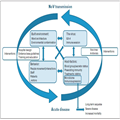Abstract and Introduction
Abstract
Purpose of review To provide an overview of the burden of norovirus disease in healthcare settings and the factors responsible for outbreaks in these institutions; to assess progress on interventions aimed at reducing the burden of norovirus disease.
Recent findings Norovirus outbreaks in healthcare settings are driven by confluence of viral diversity, the built environment, and host factors. Some of these characteristics may be modifiable and the target of successful interventions.
Summary Most norovirus outbreaks in hospital and residential care institutions are associated with a particular genotype, known as GII.4. The persistence of norovirus is associated with strain diversity, which is driven by immune evasion and viral adaptation to interaction with a variety of human histo-blood group antigens. The healthcare environment presents serious challenges for control, both because of the physical structure of the built space and the high levels of contact among patient populations who may have compromised hygiene. Increased vulnerability among the populations in healthcare institutions is likely to be multifactorial and may include the following: nutritional status, immunodeficiency or senescence, chronic inflammation, and microbiome alterations. Current control measures are based on general infection control principles, and treatment is mainly supportive and nonspecific. Vaccines and antiviral agents are being developed with promising results, but none are currently available.
Introduction
Noroviruses are endemic in the human population, affect people of all ages, and are recognized as the leading cause of infectious intestinal disease across the age range.[1–3] Norovirus outbreaks are common in many settings but predominate where there are high levels of contact and potentially compromised hygiene, such as populations in hospitals and nursing homes. In addition to the health impacts, healthcare-associated outbreaks pose a significant operational and economic burden to health systems.[4,5,6] In otherwise healthy populations norovirus gastroenteritis is generally mild and self–limiting, but there is increasing evidence that it may lead to long-term sequelae [7,8] and contribute to excess mortality in the elderly and the immunocompromised[9–16] who are inordinately affected in healthcare-associated outbreaks. At present, there are no specific interventions rigorously proven to prevent transmission and/or disease.[17–19,20]
The factors that facilitate sustained transmission in health and long-term care settings are likely to be the result of a combination of the built environment, behavior patterns associated with patients, visitors and staff, the characteristics of the norovirus strains, and/or host-related factors that influence susceptibility to disease[21,22] (Fig. 1). Noroviruses are a highly diverse set of RNA viruses, but genogroup 2 genotype 4 (GII.4) strains overwhelmingly cause these healthcare outbreaks, with elderly patients and the immunocompromised being the most frequently and/or severely affected. Health and residential-care institution-associated outbreaks occur all year round; however, they peak in the winter months, coinciding with other winter pressures on the healthcare system.[23,24] Noroviruses are likely to be introduced into these settings from the community through infected patients, visitors and/or staff, who may either be asymptomatic, presymptomatic (i.e., incubating) or symptomatic at the time of admission. Following introduction, the hospital environment can facilitate transmission. Although healthcare outbreaks are clearly linked to disease in the community, they are also distinct in terms of the intensity of their seasonality, overwhelming predominance of a single genotype and impacts on a vulnerable population. Here, we review the recent data on the viral, environmental, and host factors that are associated with the high disease burden and the challenges in controlling norovirus in healthcare settings.
Figure 1.
Interrelationships among the main drivers of healthcare associated norovirus outbreaks and potential intervention points.
Curr Opin Infect Dis. 2014;27(5):437-443. © 2014 Lippincott Williams & Wilkins











